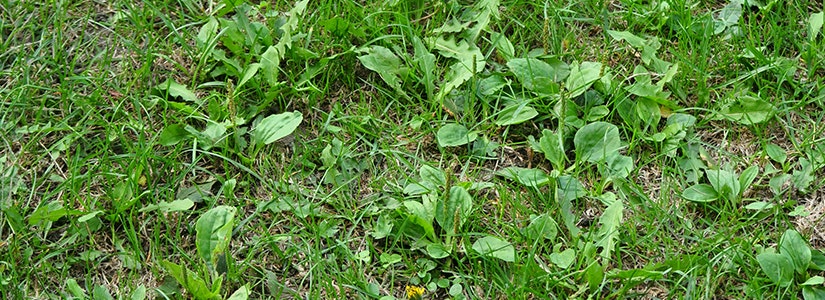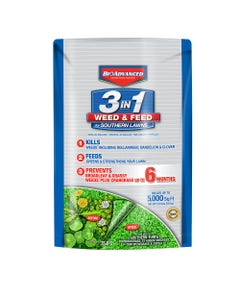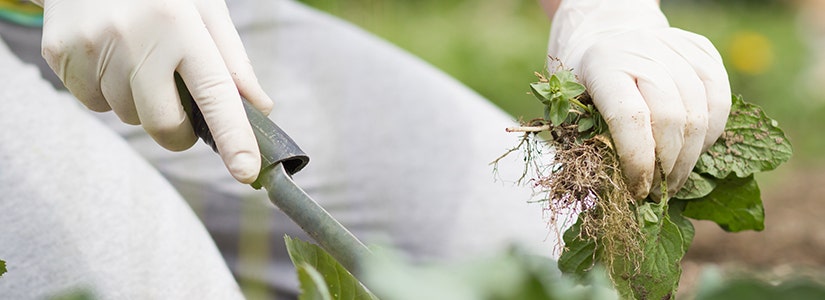

- Home
- Solution Center
- Learn
- Lawn and Landscape
- Kill Weeds In Lawns: Begin With The Basics
Kill Weeds In Lawns: Begin With The Basics
If you have a yard, you have weeds. They may lurk in the lawn, thrive under a shrub or flourish in flowerbeds, making weed control a constant battle. It requires patience, persistence and knowledge – of both types of weeds and the weapons you have to eradicate them.
What Is A Weed?
A weed is a plant that's growing where it's not wanted. Weeds aren't something you plant intentionally; they just appear. Often they grow vigorously, outpacing and overrunning desirable plants. There are several types of weeds:
Annual Weed: Completes its life cycle – from germination to setting seed – in one growing season; some annual weeds complete their life cycles in a matter of weeks, producing several generations in a single year.
Fact: Annual weed seeds can lie dormant in soil from 4-40 years.
Examples: Chickweed, Crabgrass, Lamb's-Quarters, Annual bluegrass
Perennial Weed: Lives for two or more years; plants grow as long as conditions are favorable and frequently die back to soil level with hard frost; new growth emerges at the start of the growing season, originating from roots or stem remains; in warmer regions, some perennial weeds can be green year-round.
Fact: Perennial weeds spread by various means, including seed, stems that root as they creep along or pieces of root.
Examples: Creeping Charlie, Curly Dock, Dandelion, Plantain
Broadleaf Weed: Leaves are broad and flat (not grassy or needle-like).
Fact: Broadleaf weeds are easiest to kill or remove when they're young and actively growing. Some mature broadleaf weeds develop a layer that makes it difficult for weed killers to penetrate.
Examples: Chickweed, Clover, Dandelion, Henbit
Grassy Weed: Looks and grows in ways that resemble grass; leaves are produced one at a time and look like grass blades.
Fact: Many perennial grassy weeds form rhizomes, fleshy roots that resprout if left behind in soil during hand-weeding.
Examples: Bermudagrass, Crabgrass, Giant Foxtail, Goosegrass, Quack Grass
All About Lawn Herbicides
An herbicide is a chemical used to kill weeds or inhibit plant growth. Anytime you use a weed killer, you're using an herbicide. Some herbicides have residual properties, meaning they continue to kill weeds for a specified time period following application. There are several types of herbicides:
Non-Selective Herbicide: Kills any green and growing plant, whether or not it's a weed.
Selective Herbicide: Kills only specific types of growing plants; for example, a selective herbicide may kill broadleaf weeds and not grassy plants, so that you can spray it on broadleaf weeds in a lawn without harming grass.
Pre-Emergent Herbicide: Prevents seeds from germinating or kills germinating seeds before seedlings emerge from soil; must be applied before weed seeds germinate. A common example of a pre-emergent herbicide is a Crabgrass preventer, which prevents Crabgrass seeds from establishing new plants.
Post-Emergent Herbicide: Kills weeds that are actively-growing and have already emerged from soil. It's an ideal herbicide for spot-treating lone offenders but is often applied to entire lawns. Post-emergent herbicides come in two basic forms – contact and systemic.
- Contact herbicide – only kills the plant parts the chemical touches; ideal for treating annuals and perennial weed seedlings
- Systemic herbicide – absorbed by leaves, stems or roots of a plant and moves throughout the plant, affecting every part; effective on annuals and established perennial weeds; must be applied when weeds are actively growing
Specialized Herbicide: To control some especially challenging weeds, like Nutsedge, Clover, Creeping Charlie or Bermudagrass, you'll want to choose a specific herbicide that's been proven to be effective. Ask a local garden center or your local Cooperative Extension System office to learn which herbicides will beat your toughest weeds.
Pre-Emergent Secrets to Success
- Treat the entire area – pre-emergent herbicides create a weed barrier, so if you miss a spot, weeds can sprout there. It’s vital to treat the entire area.
- Water in – most pre-emergents require watering in, even liquid forms applied using a hose-end sprayer. With liquid herbicides, the volume of water used to disperse the weed killer is not great enough to wash the material into soil, where weed seeds lie waiting to germinate. That's why you have to water after application.
- Use caution – when applying pre-emergent herbicides to newly-seeded lawns – or to areas you plan to seed. Read the label carefully. For most products, the label stipulates how many mowings, after seeding, to wait before application. The label also states how long to wait after application before sowing lawn seed.
Post-Emergent Secrets to Success
- Treat young, actively-growing weeds – they die most easily and create less of an eyesore than mature weeds, which might require repeat applications to completely kill weeds.
- Inspect the lawn frequently – while mowing is a good time to look for new weeds that have germinated and require treatment.
Timing
For both pre- and post-emergent herbicides, timing is critical. For post-emergent herbicides, you'll have the best success spraying young, actively-growing weeds. Mature weeds may require repeated applications for total kill. Most post-emergent herbicides should not be applied to dormant lawns. If applying in spring, wait until the lawn is actively growing and has been mowed at least twice.
With pre-emergent herbicides, you'll want to apply the chemical prior to the time weed seeds start germinating, which can be spring or fall depending on the type of weed. For example: cool-season weeds, such as Annual Bluegrass, are usually best controlled with a late summer to early fall application. If you apply too early, these herbicides will have degraded and are useless when seeds start to germinate. Most pre-emergent Crabgrass killers remain active in soil for 6-8 weeks. If you apply too late, the herbicide will not affect weeds that have already germinated.
Weed seed germination occurs when soil reaches the correct temperature. The best way to determine the ideal time to apply pre-emergents is to contact your local Cooperative Extension System office or master gardeners, who have access to regional soil temperature data.
Other ways to gauge application time include using bioindicators, such as plants whose growth signals the correct time for application. For instance, in northern climates, spring Crabgrass applications are often timed when Forsythia is blooming, which frequently (but not always) occurs when soil temperatures are in the 50°F range. Another option is to time applications based on the calendar. For example, if you typically apply a pre-emergent herbicide in mid-April with success, then continue that routine.
Of course, you can avoid the issue of proper application timing altogether by purchasing a weed control product that combines both pre- and post-emergent herbicides. This type of product kills existing broadleaf weeds and keeps them from returning for as long as six months.













